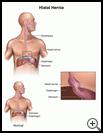
Surgery for Gastroesophageal Reflux Disease (GERD)
________________________________________________________________________
KEY POINTS
- Surgery for GERD may help control or stop the reflux when you have a hiatal hernia or when you have a weak muscle (sphincter) at the point where the stomach joins the esophagus.
- Ask your provider how long it will take to recover and how to take care of yourself at home.
- Make sure you know what symptoms or problems you should watch for and what to do if you have them.
________________________________________________________________________
What is surgery for GERD?
Gastroesophageal reflux disease (GERD) happens when the contents of your stomach back up into your esophagus (food pipe) and cause bothersome symptoms or long-term problems. A ring of muscle (sphincter) around the lower end of the esophagus pipe opens up and lets the food go into your stomach. Normally, the sphincter is strong enough to keep stomach contents from going back into your esophagus. If the sphincter is weak or too relaxed or has too much pressure working against it, stomach acid and food can flow backwards into your esophagus (reflux).
The acid and bile from your stomach can cause swelling and irritation (inflammation) of your esophagus, throat, and vocal cords. Changes in the lining of the esophagus can increase your risk of cancer of the esophagus.
Surgery for GERD may be done to help control or stop the reflux when:
- You have a hiatal hernia, which is when part of the stomach pokes through the diaphragm up into the chest, causing the reflux. The diaphragm is a muscle between your chest and belly that helps you breathe.
- The muscles (sphincter) around the top of the stomach where it joins the esophagus are weak, causing reflux.
When is it used?
Surgery for GERD may be done if:
- Your symptoms are severe and are not controlled by changes in your diet, by weight loss, or by medicine
- You do not want to or cannot continue with life-long treatment with medicine
- You have serious problems with your esophagus such as ulcers, tightness, or bleeding
- Your reflux is causing problems with hoarseness, cough, or pneumonia
How do I prepare for this procedure?
- Make plans for your care and recovery after you have the procedure. Find someone to give you a ride home after the procedure. Allow for time to rest and try to find other people to help with your day-to-day tasks while you recover.
- Your healthcare provider will tell you when to stop eating and drinking before the procedure. This helps to keep you from vomiting during the procedure.
- Tell your healthcare provider if you have any food, medicine, or other allergies such as latex.
- Follow your provider's instructions about not smoking before and after the procedure. Smokers may have more breathing problems during and after the procedure and heal more slowly. It’s best to quit 6 to 8 weeks before surgery.
- You may or may not need to take your regular medicines the day of the procedure. Tell your healthcare provider about all medicines and supplements that you take. Some products may increase your risk of side effects. Ask your healthcare provider if you need to avoid taking any medicine or supplements before the procedure.
- Follow any other instructions your healthcare provider gives you.
- Ask any questions you have before the procedure. You should understand what your healthcare provider is going to do. You have the right to make decisions about your healthcare and to give permission for any tests or procedures.
What happens during the procedure?
The procedure will be done at the hospital.
You will be given medicine called anesthesia to keep you from feeling pain. General anesthesia relaxes your muscles and puts you into a deep sleep.
Fundoplication is the repair common in the US. Your healthcare provider will:
- Repair the hiatal hernia by making the hole in the diaphragm smaller or tighter to help keep the stomach from sliding up, and prevent reflux
- Wrap a part of the stomach around the bottom of the esophagus to support the sphincter and prevent reflux
This procedure can be done in 1 of 2 ways:
- Laparoscopic surgery is done through several small cuts in the belly. A laparoscope is a lighted tube with a camera. Your provider can put the scope and tools into your belly through the small cuts. Most surgeries are done this way.
- Open surgery (with bigger cuts in the belly) may be used if you have had belly surgery before or if you have certain medical problems.
Your healthcare provider will know what type of surgery will work best to treat your symptoms.
What happens after the procedure?
Depending on the type of procedure you have, you will stay at the hospital for 1 or more days.
Follow your healthcare provider's instructions. Ask your provider:
- How long it will take to recover
- If there are activities you should avoid and when you can return to your normal activities
- How to take care of yourself at home
- What symptoms or problems you should watch for and what to do if you have them
Make sure you know when you should come back for a checkup. Keep all appointments for provider visits or tests.
What are the risks of this procedure?
Every procedure or treatment has risks. Some possible risks of this procedure include:
- You may have problems with anesthesia.
- You may have infection, bleeding, or blood clots.
- Other parts of your body may be injured during the procedure.
- You may have a hard time belching or vomiting after the procedure.
- Your reflux may return.
Ask your healthcare provider how these risks apply to you. Be sure to discuss any other questions or concerns that you may have.

